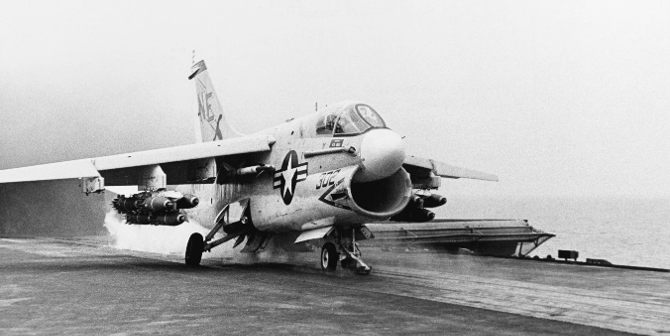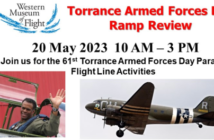It was late December 1972 aboard the USS Ranger somewhere in the Gulf of Tonkin. I was a member of an A7E Squadron, and Linebacker II (the final push of the Vietnam War) had just started. I was spotted on the aft portion of the flight deck in my fully loaded Corsair II. The load was 6 MK 82, 500-pound bombs and 4 MK 83, 1000-pound bombs and full ammo of 1000 rounds of 20 MM. That would have put my weight for the Cat shot close to max of 42,000 pounds. Normally the A7’s, were launched from the waist Cats numbers three and four, which were the ones abeam the Island in the landing area. We were used to the waist Cat’s, which released the launch bar some 10 to 15 feet prior to the end of the angle deck. That was just enough time to let the nose gear oleo strut to extend giving the airplane an attitude that didn’t require much rotation from the pilot. The bow Cat’s were usually used for the F-4 Phantom’s because they were always spotted forward. The bow catapults end just prior to the forward edge of the flight deck, not giving the A7 nose gear time to extend; thus, you went off the deck in a flat attitude requiring the pilot to rotate the airplane to a flying attitude.
For some reason the taxi director taxied me up to the number one catapult. It was a very dark night. It was going to be a head in the cockpit launch. I cannot remember ever launching off the bow with a fully loaded airplane, let alone at night. During Carrier Qualifications (CQ) on the boat we had always been at the maximum “Trap” weight or less which was approximately 23,500 pounds or so. At that weight we hardly needed the catapult as the airplane just leaped off the deck. During CQ we used the bow Cat’s exclusively because the waist Cat’s were in the landing area and landings were going on simultaneously with the launching of aircraft. The last time I had had a bow shot was during the turnaround workups several months prior.
I was now spotted on the Cat ready to go. I turned on the exterior navigation lights, which is the signal to the Cat Officer that I am ready, and shortly I was airborne. For the second time in my short Navy career I heard the God like voice over the radio, “Off the bow ROTATE, ROTATE, ROTATE!!!” I was now inside the cockpit looking at my primary flight instruments for pitch attitude, angle of attack, radar altitude and airspeed. My heart rate was off the chart! Everything looked good; the AOA was at the three o’clock position, where it should be, so I was reluctant to rotate any more for fear of stalling the airplane. Gear up, flaps up and I was in a shallow climb for the rendezvous. I was literally scared to death. I had no idea how close to the water I came that night; it was a big black hole out there.
After my return to the ship that night nobody approached me. No one asked me to come see them for a debrief; not the Squadron CO nor the CO of the ship or the LSO. No one! To this day I wake up in the middle of the night wondering how close I came to being killed on that very dark night. People have asked me over the years which was scarier, the landing or the Cat shot. I have always maintained the Cat shot was the hands down winner. You were basically along for the ride; so many things could go wrong in those very few critical seconds. I always felt I was in complete control of the landing plus I had the extra eyes of the LSO watching me on the approach.




